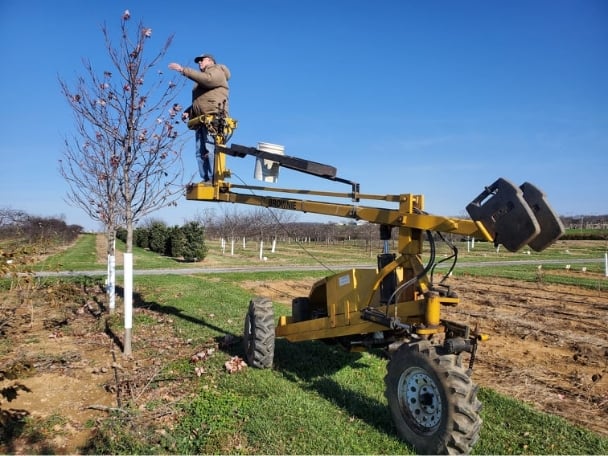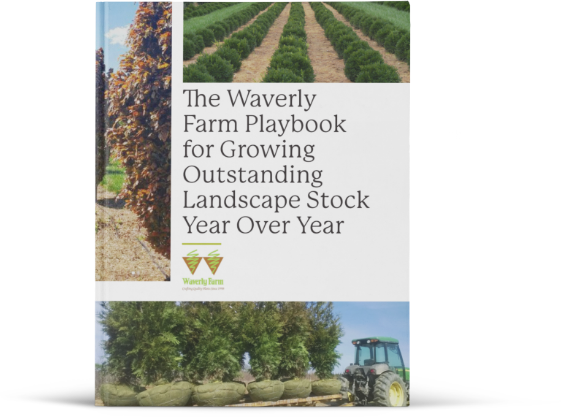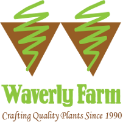Our Maryland location is at the upper boundary of Zone 7. That puts us in a perfect position to serve neighboring states to our northwest and northeast in Zones 6 and 5. Here in the mid-Atlantic region, we benefit from growing conditions that sit comfortably between the hard long winters of the north and the prolonged heat and humidity of the south.
We take advantage of the long shoulder seasons and a milder winter to grow hardy, healthy plants that are well-suited for planting in neighboring states. This long growing season accelerates our production timeline, allowing us to bring our plants to fully finished size sooner than growers located in the states we serve.
The Value of Field Grown Trees and Shrubs
Eighty to ninety percent of our plants are propagated on site
We have invested in growing sought after shrubs and trees that are hard to find in large sizes and fully developed form. Most of the field grown plants we sell are available elsewhere in containers, but the container grown stocks are not of equal value because most are grown too quickly to allow time for good development.
Of the nearly 400 different genera, species, and cultivars on the farm, here are a few of the most sought after plants that we grow in quantity.
Ilex
Holly takes time and skill to successfully grow in the field. When grown in containers, they tend to be leggy and the limb structure is thin. Ilex will grow up to 24” per year but we aggressively prune them to allow only 6” inches of new growth per year because this strengthens the core structure and makes the plant dense. When ours are ready for sale “you can stick a pencil in them and it won’t fall out.” View Ilex
Viburnum
Field growing produces a hefty, heavier plant that container growers can only dream about. View Viburnum
Syringa
The lilac is a high value plant in the industry. It holds sentimental value for many people and there is a place for it in most yards. Although we are expanding the palette to get beyond the old standards, syringa vulgaris is still in highest demand because it is the traditional lilac most people know. Lilac grows faster in our mid-Atlantic growing zone but most of ours are shipped up North because it does not like high heat and humidity here (powdery mildew). We give our lilacs an extra two or three years to develop fully before harvesting. View Syringa
Buxus
Boxwood is ubiquitous in American landscapes. It is versatile, deer proof, can be shaped in any form, or hedged. Some growers and landscapers stay away from it because it is vulnerable to an imported disease called boxwood blight. The blight took the industry by surprise when it first appeared, but we now know the blight can be managed and prevented with fungicide treatments. Also, there are buxus cultivars that are blight resistant. View Buxus
Hibiscus
A classic landscape shrub. This abundant bloomer, a.k.a. Rose of Sharon, continues to hold a place in the hearts of many people. We’ve seen renewed interest since the arrival of several dozen new cultivars. View Hibiscus
Our Extensive Plant Catalog
Waverly Farm maintains an extensive catalog representing more than 400 cultivars of the most in-demand shrubs and ornamentals on our 200 acre facility. Our stock is 100% field grown, 90% propagated on site, and available in larger sizes not readily available from most growers.
Beautiful, Versatile Cultivars
It wasn’t on your list, but maybe you should think about giving it a try!
Some of the plant material we grow is easy to find in containers but not in large sizes. Field growing produces larger, more developed plant stock—which equals greater value.
Dragon Lady Holly
This holly is hard to find in a large size. Since it is a fast grower, we prune the leader to hold vertical growth to 6” inches per year. This encourages the plants to branch out laterally and achieve superior density. By selling time, “you can stick a pencil in them and it won’t fall out”. View Dragon Lady Holly
Thuja and Juniperus
Thuja is always in high demand for privacy screening. We grow dozens of cultivars (T. plicata ‘Green Giant’ , T. occidentalis ‘DeGroot Spire’, J. virginiana ‘Taylor’) and some are deer safe. Green Giant has been a huge seller for ten years and going. It is another one of those fast growers (up to 36 inches per year) that we also prune aggressively. We trim it on the sides and cut the leader back two or three times a year to prevent it from being too open. This practice develops a sturdy, robust plant that provides many Thuja occidentalis benefits. View Thuja or View Juniperus
Fagus
We grow red, purple, green, and golden cultivars. Beech is extremely slow growing and not so easily found in nurseries as it used to be. The decline in field production is driven by slow growth; up to fifteen years here. View Fagus
Cornus
Always in demand, there are two basic categories of dogwood: chinensis (from Asia) and cornus florida (U.S. native). Both come in a wide variety of cultivars including a third category of hybrids that cross C. florida with chinensis. Cornus florida blooms before the leaves appear. Chinensis and the hybrids bloom after the leaves. View Cornus

Innovation & Experimentation
Our Instant Privacy Hedge Growing System
Inspired by a tour of nursery facilities in The Netherlands, we developed our own system for producing finished hedges on site. We grow various hedging plants in sets of three that are carefully pruned to grow together. At harvest, we separate individual plants for shipping. One face of each plant will be numbered for easy installation in the order they were grown.
Plant Categories
What role do you want your plants to perform in the landscape?
What conditions must your plants be able to tolerate?

The Waverly Farm Playbook for Growing Outstanding Landscape Stock Year Over Year
Your success as a landscape professional depends on developing long-term partnerships with the most reliable growers as trusted sources for high quality plant stock.
This eBook will help you in your search by identifying key characteristics to look for in a grower capable of producing plants that have year over year consistency in health, size, and fullness.





